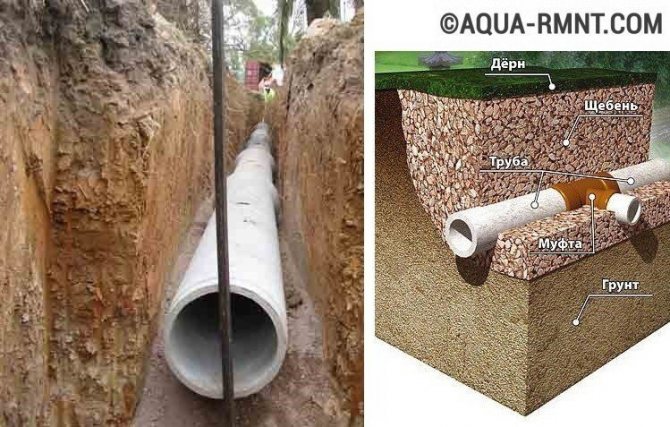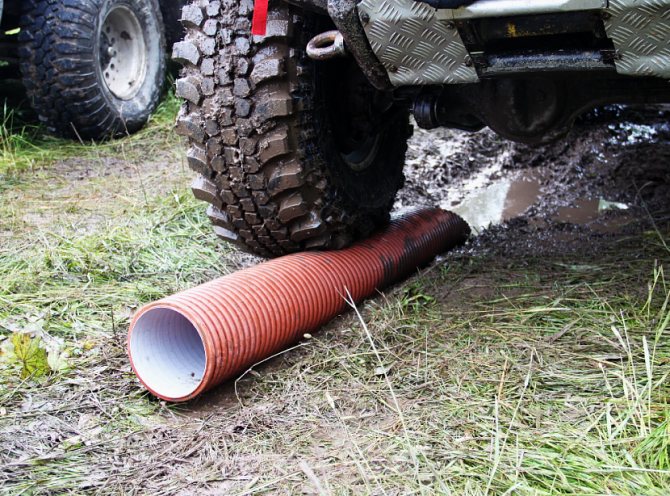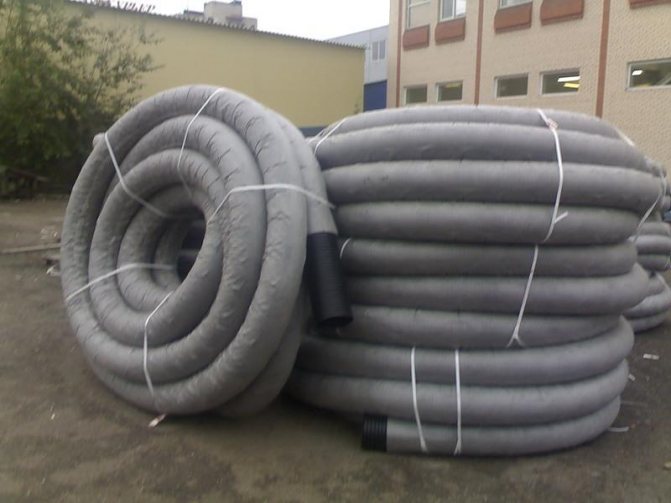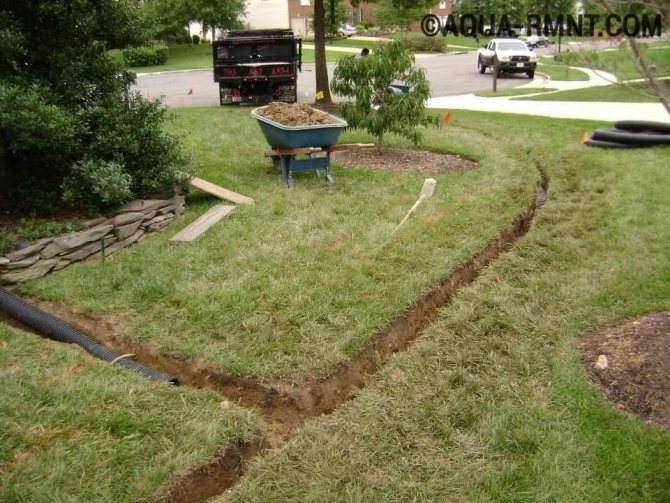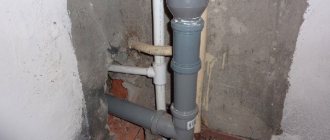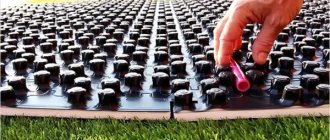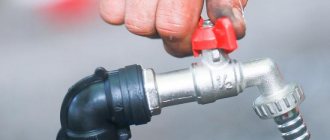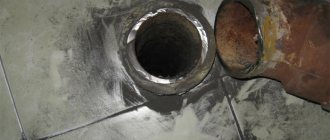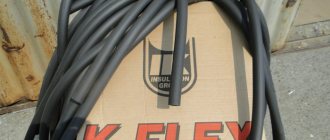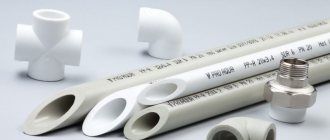Hello dear interlocutor!
In the construction of a house, in addition to the construction of the structure itself, there are many important nuances. It is scary to imagine, for example, what would happen to a precious cottage in the event of a systematic flooding of the foundation with sewage.
That is why today's article will focus on a very necessary and important system - the drainage system.
And in particular - about what the optimal drainage pipe should be for your site.
What is drainage and how it works
Drainage is a structure created to drain the land from special drainage pipes and auxiliary devices. Serves to drain ground water from the local area.

Soil waters in central Russia are often located high - at a depth of 2 m from the surface of the earth and even higher. Underground moisture destroys the foundation of the structure and causes rotting of plant roots. Before building a house, it is imperative to carry out engineering surveys and find out the depth of the soil.
How to understand that drainage is needed?
- Your site is located on a slope or vice versa in a lowland;
- If the surface of the territory is flat and there is nowhere for water to drain, it stagnates and swamps the area;
- There are severe floods in your area;
- The walls of the house freeze in winter;
- The room is humid, mold and mildew form.
All these direct and indirect signs indicate the need for forced drainage of the site.
How does drainage work?
The soil drainage system can be of three types - open, closed and point.
- Open system
Serves to drain surface waters (rain, melted snow, flood waters, etc.).
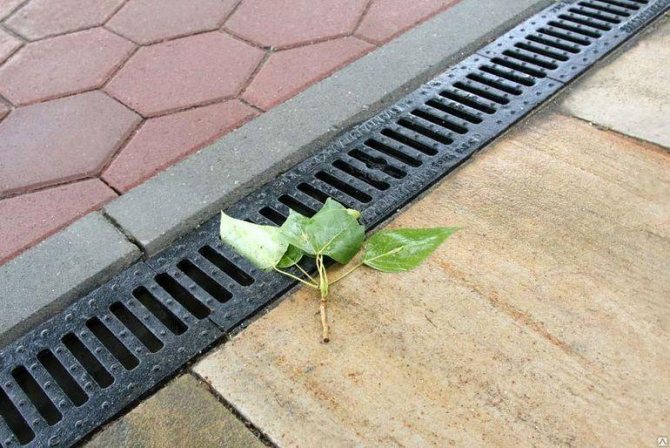

For the device of an open structure, a trench 50 cm deep and 60-70 cm wide is dug around the entire perimeter of the site. The collected water should be poured into a general drain. If the site is not located on a slope, ditches should be dug with a certain slope so that the water does not stagnate, but flows from the territory. The ditch is left empty (drainage without pipes), or reinforced with stones, cement. A special open drainage pipe can be laid.
- Closed system
More complex. The trenches here are from 1 to 1.5 m deep, 0.25-0.5 meters wide. The depth of the laying should be greater than the depth of soil freezing.
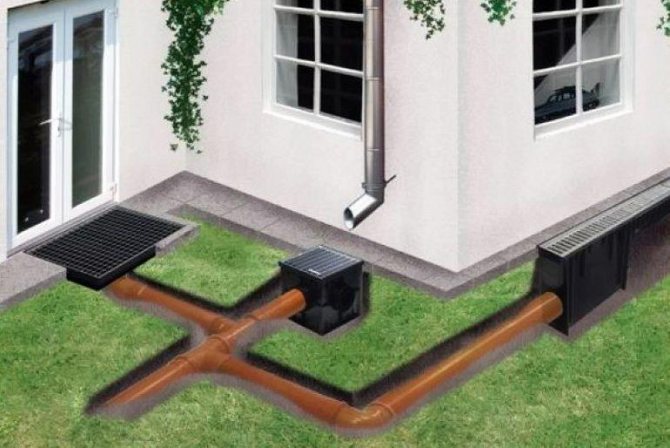

It is necessary to lay a sand and crushed stone pillow in the trench, and on top of it a special perforated pipe of the required diameter. You need to dig a ditch with a slope towards the well or drain. Remains of a gravel-sand mixture are laid on top. To avoid clogging and silting, drainage pipes must be additionally protected with filter material.
All the collected water enters the storage tank, from it into the reservoir, or into the sewer. To control the state of the system, it is necessary to install special inspection chambers.
- Point
Single installed receivers in the places of the greatest water accumulation. Several installed local receivers can be connected to a single network. The main elements of point drainage are storm inlets and outlets.


A well-chosen and correctly installed drainage system will protect the upper layers of the soil from erosion, the foundation of the house - from cracks, will preserve the decorative coating in the yard and will have a beneficial effect on soil fertility. Therefore, in no case should you neglect drainage.
Why is plumbing or sewer not suitable?
Conventional water or sewer pipes are made without special holes.Products without perforation can only be used to drain already collected liquid.
What is perforation for?
Through the technological holes, water from the soil enters the pipe and moves along it to the drain common for the entire section.
The drainage pipe (deep) must be perforated.
How and why does drainage work?
An artificially constructed watercourse is a system of underground pipelines and surface channels for collecting water. Moisture enters special containers, and then is removed outside the site.
Drainage can be carried out both into natural reservoirs and city sewers.
It is possible to determine whether the site needs draining by indirect signs. The high moisture content of the soil is evidenced by:
- the presence of moisture-loving plants (for example, nettles); flooding of cellars and basements; long drying of the site after rain (large puddles remain, from which water does not leave well).
But even in the absence of such alarming signs, buildings are not insured against water damage. For example, during the period of heavy rains or during the active melting of snow. For this reason, experts recommend in any case to install drainage around the foundation with their own hands and equip storm drains.
The main advantage of this type of drainage systems is the exclusion of expensive treatment facilities and other technical units. A complete system consists of:
- from drainage pipes; storm drains (gutters and storm water inlets); sand traps - special mechanical filters at the entrance to the system collector; general drainage wells; collector with a non-return valve (from here, water is discharged into the ground or reservoir).
Types of drainage pipes
Products vary in material, surface, stiffness and load carrying capacity. Let's consider each variety separately.
By material:
Most often, pipelines for water drainage are made of asbestos cement, ceramics, and plastic. Less common are chrysotile cement, metal pipes and products with the addition of polystyrene.
Asbestos-cement
Asbestos cement is a waterproof and fire-resistant material. Made from cement and asbestos fibers.
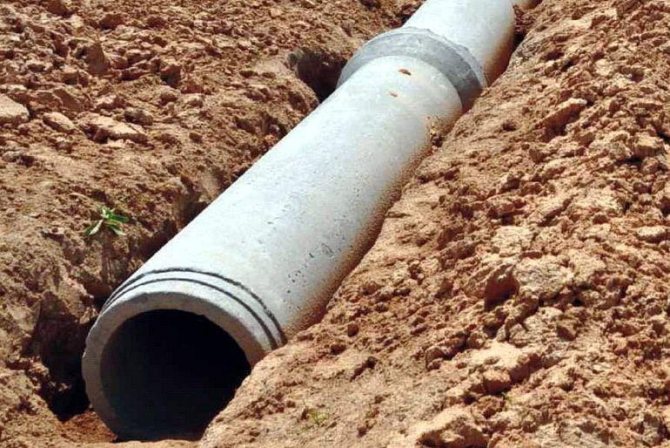

At the moment, asbestos pipes are rarely used due to the large weight of the product and the difficulties of installation. Drainage holes in such pipes are difficult to make on your own, and the finished system has low operational properties.
Chrysotile cement
Chrysotile-cement parts are the closest relatives of asbestos-cement ones. They also contain white asbestos fibers called chrysotile. Chrysotile is packed in a concrete matrix. In the last century, the material was considered carcinogenic.
The advantages of chrysotile cement drainage systems are water tightness, resistance to mechanical stress, good response to high pressure, service life of -25 years and more. Cons - heavy weight, installation difficulties, slow assembly process.
Ceramic
They are made from a special type of clay with subsequent firing. Ceramic drainage products are durable, high pressure resistant, environmentally friendly. The range of diameters produced is not great - from 5 to 30 cm.
A too low coefficient of surface friction makes it difficult to install filters.
Polymer
Polymer parts, in turn, are subdivided into products made of polyethylene (HDPE), polyvinyl chloride (PVC), and polypropylene.
Mon
Drainage pipes HDPE are made of polyethylene of sufficiently high stiffness classes SN4 and SN8. They are used for both deep and surface pipelines. Sizes range from 5 to 70 cm in diameter.


There are single-layer, double-layer and perforated versions of products with joints in the form of couplings, welding and socket.
Details from HDPE are flammable.
Polypropylene
A frequently used product. The closest relative of the HDPE. Available in crimped and smooth. The minimum pipe diameter is 50mm, stiffness class SN8.
Pvc
Drainage pipes made of PVC (polyvinyl chloride) are no less popular for the arrangement of pipelines than the previous 2 plastic types of pipes.
Produced in the following modifications:
- Rigid and flexible;
- With and without filter material;
- Single layer and double layer.
Supplied in lengths of 6 and 12m and in coils.
When buying a pipe, you should pay attention to the stiffness class, PVC products are available in a wide range, from SN2 to SN16.
With expanded polystyrene
The structure is a perforated pipe inside a geotextile filtering shell filled with expanded polystyrene granules. Special pellet channels improve water drainage. Expanded polystyrene is resistant to all liquid media, tolerates low temperatures, has a long service life (up to 100 years) and is unattractive to rodents.


The need to use this particular type is due to the following factors:
- Groundwater is too close to the surface;
- The site is dominated by alumina;
- The site is located in a lowland and is prone to waterlogging;
Standard dimensions - core D = 110 mm, total diameter of the drainage system - 300 mm.
Corrugated
Corrugated pipes are made in the form of a plastic accordion. Drainage holes in such products can be either round or slotted.
Advantages of corrugated products:
- Light weight;
- Simple and fast styling technology;
- Reliability;
- High corrosion resistance;
- Strength and durability;
- High level of ring stiffness;
- A wide range of applications - pipes are produced with different degrees of rigidity, which makes it possible to select products directly for
Single-layer and multi-layer
Pros of multilayer pipes:
- Several layers give the product extra strength and durability. The top layer is often corrugated, the inner layer is smooth. They are designated by the SNX marking, where X is the maximum drainage depth in meters.
- Single-layer pipes are most often used for local drainage systems. They can be smooth or corrugated.
Flexible and tough
Pipes are divided into 2 types, depending on the stiffness:
- Flexible models: Used to create flows with a rounded perimeter. They are characterized by lower ring stiffness and strength. Produced in the form of bays. Convenient because there is no need to install a large number of connecting elements.
- Rigid pipes: Used for laying straight sections. Available in thick-walled and thin-walled. They have a higher strength factor than flexible ones, but when laying, additional fittings cannot be dispensed with.
Perforated
Drainage pipes for groundwater drainage are produced with perforations. The diameter of the technological holes is made from 1.5 to 5 mm. Holes are located in different products either around the entire circle, or ½ and 1/3 of it.
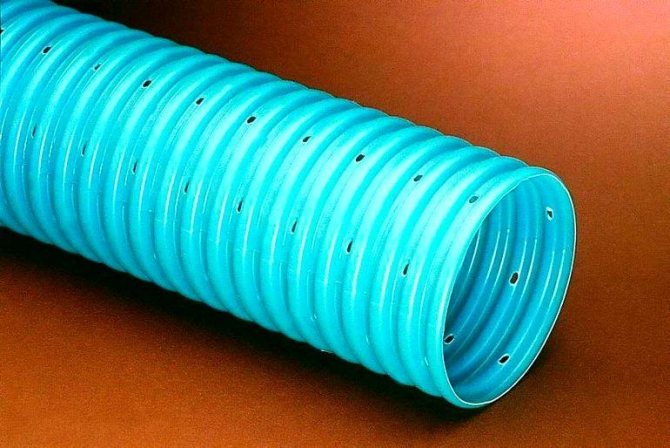

Non-perforated products are only suitable for specially designed systems where moisture is collected from a common source and transported to the drain.
Perforated drains are called suction (collecting) drains.
With filtering layer
Without filtration, process holes quickly become clogged and their throughput decreases. The filtering layer of pipes is made of geotextile or coconut fiber.
In geotextile
Geotextile is a non-woven fabric, most often black. Placed on top of the pipe and used as a sieve to prevent dirt from entering.
Such a drainage pipe lives in the ground for a long time and, accordingly, retains its operational properties for a long time.
Coconut wrapped
Coconut fiber as a pipe wrapper has its pros and cons.The advantages include environmental friendliness, high elasticity and permeability, high resistance to decay and deformation. The only negative is the high cost of construction.
Still
In addition to the above, metal perforated pipelines from special alloys are extremely rarely used. They are used in industries where chemical waste can enter the wastewater. Using such products at home does not make sense.
Material
Manufacturers offer products made of asbestos cement, polyethylene (with perforation) and polyvinyl chloride (you can do the perforation yourself).
Asbestos cement is the cheapest material. However, there are big doubts about its environmental safety. Therefore, an increasing number of buyers are opting for durable plastic products.
Ready-made perforated drains are realized in geotextile wrap. Cheaper PVC pipes require additional processing - cuts are made in a checkerboard pattern up to 5 mm wide. Processing is carried out on both sides.
The distance between the cuts is 50 centimeters. Additionally, you will need to purchase geotextile for wrapping the pipe before laying it in the ground. The fabric serves as a filter and prevents liquid dirt from clogging the perforated pipes.
Which is better?
For storm water
Smooth plastic pipes with a minimum stiffness factor (eg SN2) are ideal for collecting surface water.
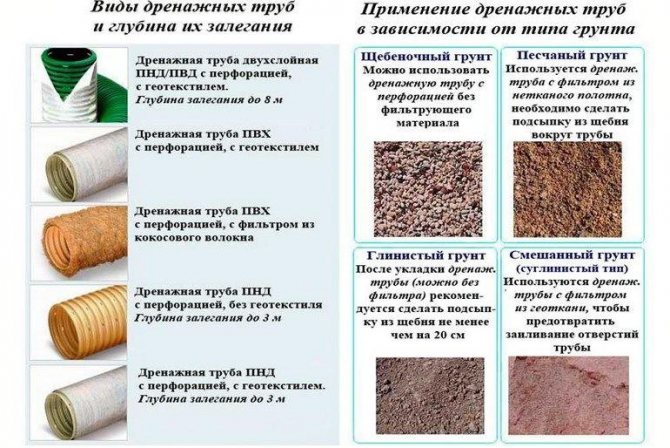

Do not overpay for products with high strength characteristics. Corrugation is not needed here either.
For groundwater drainage
For groundwater drainage, the most successful choice will be a corrugated multilayer pipe with perforation and protection in the form of a coconut filter. Yes, this product is not the cheapest on the market. But such a pipe will 100% save your foundation from destruction, and, accordingly, from huge financial costs.
It is imperative to choose a pipe based on the SN parameter.
Technical and geometric parameters
Drainage pipes have the following working qualities:


Manufacturing material... There are tons of options here to suit different conditions.- Diameter. The most popular pipes are from 160 to 200 mm, but for areas with a large inflow, pipes of 300-400 mm are often used.
- Perforation type... There is a solid, partial perforation with a hole diameter of 1.3 mm. In addition, there are non-perforated pipes that are used to supply moisture to the discharge points. There are pipes with perforation in the form of short slots, which are used on clayey soils.
- Wall construction... There are corrugated and straight pipes, one and two layers.
Depending on the material, pipes have additional parameters - weight, degree of rigidity, ability to withstand mechanical loads. At the same time, the basic parameters that have already been considered are always the main parameters.
The choice of suitable drains depends on the operating conditions:
- depth and place of laying,
- volume of water flow,
- the presence of additional loads (for example, placement under the roadway) and other factors.
Drainage table for different soils
If the pipeline is laid incorrectly, for example, above the level of freezing of the soil, then in winter it will freeze. There are 2 options here - either lay the pipes below this level, or insulate them well. Let's summarize the data on the recommended types of drainage pipes, depending on the types of soil in the table.
| Soil Type | Type of drains |
| Crushed stone | Perforated without filter material |
| Sandy | Any kind with the obligatory use of a filter |
| Clayey | You can use pipes made of any material, it is possible without a filter, but with the obligatory addition of crushed stone |
| Loam | Be sure to use geotextiles or coconut fiber. |
The table of the dependence of the distances between the drainage areas on the type of soil and the depth of the drains is given below:
| Drain depth, m | Distance between drains, m | ||
| Light soils | Medium soils | Heavy clay soils | |
| 1.8 | 18-22 | 15-18 | 7-11 |
| 1.5 | 15.5-18 | 12-15 | 6.5-9 |
| 1.2 | 12-15 | 10-12 | 4.5-7 |
| 0.9 | 9-11 | 7-9 | 4-5.5 |
| 0.6 | 6.5-7.5 | 5=6.5 | 3-4 |
| 0.45 | 4.5-5.5 | 4-5 | 2-3 |
Drainage pipe manufacturers
I propose to consider several leading manufacturers of plastic elements and find out how their products differ from each other.
Pragma
PRAGMA® is a brand of high-strength polypropylene pipes. Corrugated, red, made with a double structured wall made of PPR-B polypropylene. Withstands temperatures up to +60 degrees.
Perforated
A kind of Korsis pipes. The products of this brand use high-modulus polyethylene with the addition of mineral impurities, which give additional rigidity. They are produced in two types - with perforation only in the upper part or with holes along the entire surface.
Corsis
These are two-layer polyethylene pipes for storm water and shallow drainage. The outer layer is black and corrugated for UV resistance. The inner one is smooth to allow water to pass through, it is made in white. The white color makes it easier to inspect the inner surface of the pipe.
Softrock
Softrock is a ready-made system that allows you to reduce the amount of work on laying and assembling drainage.
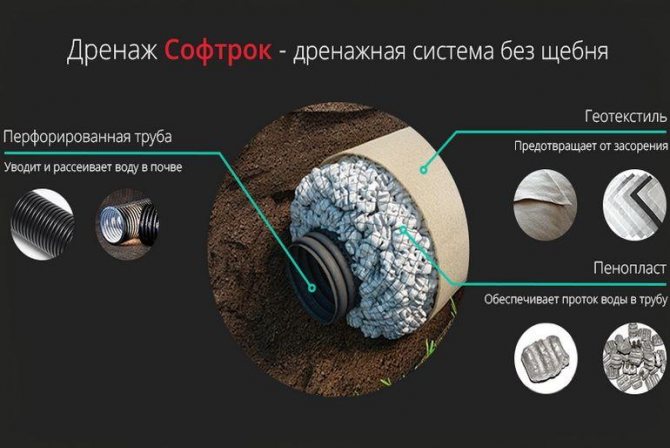

Flexible perforated pipes are surrounded by expanded polystyrene core, packed in a geotextile mesh. Additionally, the kit includes additional fittings. Pipe diameters -110, 160, 200mm. Outside diameter -300mm, Strength class SN4, pipe length -3m.
Pipes Logistics
The Logistics pipe is a flat rectangular pipe, supplied in coils. Made of polyethylene. Has internal reinforcing elements. The tube is compact and takes up 2.5 times less than conventional round tubes.
Uponor
Products made of high density polyethylene with a double wall. The single-layer pipes are equipped with a coconut fiber filter.
SK-Plast
The company produces smooth and perforated products in both multi-layer and single-layer versions. Products of the STS brand are distinguished by their versatility and affordable price.
Dimensions and diameters
The choice of the pipe diameter is the most important step in the design of the drainage system.
To drain a significant volume of water, you will need products of large diameter (at least 300-400mm). For domestic needs 200mm is enough. The most commonly used pipe is 110mm. To calculate the required diameter, it is necessary to take into account the degree of soil moisture, filtration coefficient, freezing capacity, inflow volume and other terrain features (indicated in the relevant reference books).


For an area of 400m2, 110mm in section will be enough. If the area is larger, 200mm pipes will do. Industrial areas are drained with larger diameter products. The width of the trench should be 40 cm larger than the diameter of the pipe.
Drainage system installation
Wall drainage of the foundation near the house
The device of the drainage system begins with design work. The following points are noted on the site plan:
- location of drainage pipes;
- the length and depth of future trenches;
- places where drainage and inspection wells are located;
- how the water will be discharged into the storm sewer (sometimes replaced by a container for collecting water).
Inspection wells should be checked every season
Note! The project specifies the type of soil characteristic of the land plot. It also contains information on the level of groundwater occurrence and the level of soil freezing.
It is clear that it is difficult to do such calculations yourself; this requires special knowledge. If you resort to the services of designers, they will professionally make measurements, calculate the necessary indicators and draw up a project for the drainage system of the site. Everything related to the technical side of the drainage device without pipes or with them can be done independently. The order of work is as follows.
- Before laying plastic pipes, prepare a trench according to the dimensions specified in the project.With a shallow depth of soil freezing, when it is possible to work freely in a trench, its width should be 40-50 cm more than the diameter of the pipe.
If the depth of soil freezing is large, it is more convenient to dig the ground when the width of the trench allows a person to turn around with a shovel. There are no exact instructions in this case, the main thing is that it is convenient to do the work.
- When the trench has been dug, line the bottom and walls with geotextiles. It will protect the holes in the pipes from siltation.
- On top of the geotextile, add sand first and then crushed stone.
- Lay a perforated plastic pipe on the crushed stone layer and backfill it in the reverse order - first with crushed stone, then with sand, cover with geotextile and lay the previously selected soil on top.
On a note! Make sure that the slope of the drainage pipe from the building to the location of drainage wells or other collection of waste water is observed. Stick to 3 degrees throughout the entire branch of the mounted system.
- Arrange inspection wells while laying the pipeline. They will be needed to control the water level in the system and, in case of clogging, to clear it of accumulated debris.
Important! Inspection wells are located along the entire length of the drainage system. The distance between them is no more than 50 meters. Such elements are necessarily provided in places of a sharp change in the slope of pipes and at bends of the drainage system.
- Make sure that the collected water is discharged into a storm sewer or special reservoir. In the future, you can use it for watering the garden or other household purposes.
- In the case when it is planned to drain water into an open reservoir - a river, lake, pond (or storm drain), be sure to install check valves at the ends of the drainage pipes.
On a note! Sometimes it is advisable to make a herringbone drainage system. In this case, perforated pipes are diverted from the main drainage branch. Such a junction of drainage pipes resembles twigs from above extending from a tree trunk.
Branched drainage system
Where to buy and how much they cost
You can buy products at any hardware or hardware store, on the market, or order delivery directly to your home on the Internet. The approximate cost of popular plastic products per 1 running meter:
- Single layer with the most popular diameter 110mm 110-130rub;
- Single-layer with a geotextile filter - 240-280 rubles;
- With a filter made of coconut fiber-300-350 rubles / m;
- Two-layer - 130-150 rubles / m.
The cost of products depends on the manufacturer and the material of manufacture.
Drainage installation and maintenance
Ditch preparation
Ditches for the drainage system can be dug manually or using special equipment. The width of the trenches should be 40-45 cm larger than the diameter of the pipeline. The distance between the drainage ditches is shown in the table above.


Trenches must be dug with a slope of 0.5-0.7% towards the collection of moisture. At the bottom of the trench, a layer of sandy soil 20 cm thick is laid, then the same layer of crushed stone.
DIY styling
It is done as follows:
- Drainage pipes are placed in the prepared ditch. If the perforation is made only on one side, then during assembly they should be laid with the holes down;
- The elements of the pipeline are connected to each other using special fittings with sockets.
- At turns of the line, it is necessary to provide for the installation of wells.
Backfilling
- The buried pipe is covered with a layer of rubble;
- A layer of sand must be poured over the rubble;
- A previously cut sod is laid on top of the trench.
Methods for arranging a drainage structure
Thinking about how to lay a drainage pipe, you need to understand that there are several ways to install drainage structures:
Trenches with crushed stone and sand. Closed type drainage, which is a groove dug in the ground, filled with a layer of crushed stone, on top of which sand is laid. For the best effect, they can be performed in the form of a "herringbone", while the central trench, to which the secondary ones approach, should be made with a slope directed towards the point of water discharge. The distance between the drains is selected depending on the composition of the soil.
On clayey, it should not exceed 10, loam - 20 and sandy - 50 m. Open drainage. The easiest and cheapest option in the device. It is a groove, half a meter wide and about 70 cm deep, dug around the perimeter of the site.
The sides in the drains are made chamfered, at an angle of about 30 °. Water is discharged from the system into a common gutter. The main drawback of the design is an unaesthetic appearance, somewhat spoiling the landscape of the site. The design is using a perforated pipeline.
The most common drainage pipe laying technology. Deep drainage designed to drain high-lying groundwater. Ceramic or asbestos-cement pipes with drilled holes are laid in the ground.
A more modern option is perforated plastic or ready-to-install drainage systems that can be found commercially. This is a surface drainage that allows moisture to be removed from the site in the form of precipitation. For the arrangement of the structure, special trays are used, which can be made of modified concrete or plastic.
The trenches are led from the water intakes to the discharge point, while a slight slope must be observed, of the order of 2-3 °. Parts are installed in small grooves, their sides must be at ground level. From above, the trays must be covered with decorative grilles.
If the area is elevated, open drainage grooves are dug across the slope. Thus, it will be possible to "intercept" the water flowing down from the top.
The disadvantage of an open drainage system is considered a somewhat unaesthetic design.
This is the most popular drainage system for owners of private plots and country houses.
Drainage trays are used to drain excess moisture that falls on the site in the form of precipitation.
Savings tips
Tips for saving when installing a drainage system go from the opposite. T, E, boil down to the fact that it is better to spend money on a competent drainage device than on the subsequent reconstruction of the house.
- Geological surveys must always be carried out before the installation of the drainage system! This will allow you to make the system working the first time and not to alter it later.
- Choose either coconut filters or quality geotextiles. Do not be lazy to familiarize yourself with its characteristics when buying;
- Instead of cheap crushed limestone, it is better to use granite, which will not be washed out with water later.
When a drainage device is needed
Drainage refers to the removal of excess water from deep within the earth or soil surface. This is done naturally or artificially. In agricultural engineering and construction, canals, drainage wells, wells, underground pipelines and other devices are used to drain groundwater and storm water.


Drainage system in section
The need for a drainage system arises in the following cases:
- groundwater at the site is located too high to the surface of the earth;
- construction of a residential building with a basement is planned;
- desire to change the existing relief;
- the presence of clay soils that impede the natural escape of melt and storm water.
Drainage pipe materials
In those days, when there were no plastic materials, pipes made of ceramics, asbestos and steel were used for the installation of land drainage.To obtain a complete drainage system, holes were drilled in such structures. This was done manually, so the process was time consuming and complex. After laying such a drainage pipe, the holes were clogged with soil over time. The expended efforts became in vain, and the system ceased to fulfill its function.
Nowadays, the possibilities of choosing pipes for the device for draining ground and surface waters have expanded. The best option is a corrugated plastic pipe, in which ready-made holes have been made. So that the holes do not silt up and do not float with soil, loose geotextiles are used for protection, which is wrapped around the drainage structure. This material pleases with an affordable price.
On a note! The drainage system can be made by yourself. The process is simple, the main thing is to adhere to the production technology of the work.
An extrusion line is used for the production of corrugated drainage pipes. It is possible to produce products of different diameters (at the request of the customer). The dimensions of such elements range from 63 to 200 mm.
The advantages of plastic
Products made from artificial polymers have the following advantages over natural materials.
- Plastic has a long service life - 50 years or more.
- Pipes made of polyvinyl chloride, polyethylene and other artificial materials can be easily processed with improvised tools that every owner of the house can find.
- If necessary, plastic pipes for drainage can be laid to any depth.
- Thanks to their design features, the pipes are easily assembled into a single system. Various fittings and accessories for drainage pipes help in this.
- Plastic products cost several times less than their ceramic and metal counterparts.
Drainage pipe cleaning
Even with a good filter, the pipeline gradually clogs up. There are 2 ways to clean it.
Mechanical method
The mechanical cleaning method is used for heavy contamination of pipelines. The basic principle of operation is the use of brute force. Either a cleaning ball or a plumbing cable with a spiral is used as a working tool.
In case of severe contamination, flushing is not enough, the water is not able to cope with all layers of silt and dense plugs. We'll have to resort to a mechanical method of cleaning the drain. Some blockages can only be destroyed by brute force.
A plumbing cable or ball can be used as a working tool for mechanical cleaning.
Hydrodynamic method
In most cases, a regular garden hose filled with water is sufficient to flush the system. Water must be supplied to the system under pressure.

